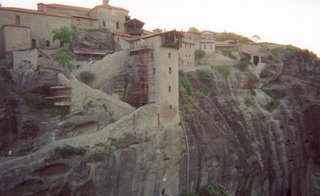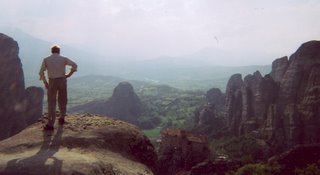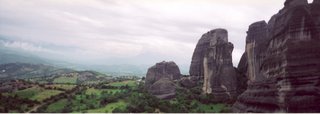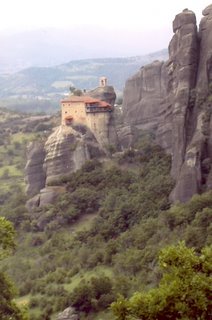The geology of Meteora: It had been, in remote times, undersea, rivers then carving around prominences as water fell, land exposed. See http://www.meteora-greece.com/
 Meteora, Monastery, Greece
Meteora, Monastery, Greece
Monasteries were constructed on cliff-tops, many on free-standing geological formations like air islands. If At the center here, see see the ropes hanging down that suspended the baskets that were the only way up for people and goods in the old days. There also was a suspended rope between the monastery and the cliff on the other side, for a way over. See http://www.in2greece.com/english/places/historical/mainland/acropolis.
Geo-tourism: This site would be excellent. See book "Geotourism" by Ross Dowling at this site: http://www.elsevier.com/wps/find/bookdescription.cws_home/706060/description#description.
 Meteora view, Monasteries, Greece
Meteora view, Monasteries, Greece
These monasteries were built around 1100 AD and thereafter, by hermits and monastics fleeing from the invading Ottomans, or for their own reasons - preferring isolation. See history of Meteora, http://www.greeka.com/thessaly/meteora/meteora-history.htm
There is an entire area of these stacks with or without structures on top. See www.orthodox-monasteries.com/greece/index5. See also www.in2greece.com/english/places/historical/mainland/meteora.
 Meteora, Creece. Conglomerate rock formations, and medieval monasteries
Meteora, Creece. Conglomerate rock formations, and medieval monasteries
One story of how these were built:
 Rock formations, monastery at summit, Meteora, Greece
Rock formations, monastery at summit, Meteora, Greece
These are World Heritage Sites. The area is on the list for many tour groups. See www.great-adventures.com/destinations/greece/meteora.
Wardrobe for Orthodox areas:
This is an orthodox area. Ladies, wear a skirt (I had a denim one, mid-calf, for easier climbing). Some women had a light shawl wrap, square-ish, that could be wrapped like a sarong to cover trousers.
 Clifftop monastery, Meteora, Greece
Clifftop monastery, Meteora, Greece
 Meteora, Monastery, Greece
Meteora, Monastery, GreeceMonasteries were constructed on cliff-tops, many on free-standing geological formations like air islands. If At the center here, see see the ropes hanging down that suspended the baskets that were the only way up for people and goods in the old days. There also was a suspended rope between the monastery and the cliff on the other side, for a way over. See http://www.in2greece.com/english/places/historical/mainland/acropolis.
Geo-tourism: This site would be excellent. See book "Geotourism" by Ross Dowling at this site: http://www.elsevier.com/wps/find/bookdescription.cws_home/706060/description#description.
 Meteora view, Monasteries, Greece
Meteora view, Monasteries, GreeceThese monasteries were built around 1100 AD and thereafter, by hermits and monastics fleeing from the invading Ottomans, or for their own reasons - preferring isolation. See history of Meteora, http://www.greeka.com/thessaly/meteora/meteora-history.htm
There is an entire area of these stacks with or without structures on top. See www.orthodox-monasteries.com/greece/index5. See also www.in2greece.com/english/places/historical/mainland/meteora.
 Meteora, Creece. Conglomerate rock formations, and medieval monasteries
Meteora, Creece. Conglomerate rock formations, and medieval monasteries One story of how these were built:
- A hermit made his way to the top of one summit, and wondered how to proceed with shelter. An eagle came by and dropped him a feather. Then, it dropped a piece of twig, and then enough materials to fashion a rope.
 Rock formations, monastery at summit, Meteora, Greece
Rock formations, monastery at summit, Meteora, GreeceThese are World Heritage Sites. The area is on the list for many tour groups. See www.great-adventures.com/destinations/greece/meteora.
Wardrobe for Orthodox areas:
This is an orthodox area. Ladies, wear a skirt (I had a denim one, mid-calf, for easier climbing). Some women had a light shawl wrap, square-ish, that could be wrapped like a sarong to cover trousers.
- . If you are dressed inappropriately, including either long pants or shorts, the monastery will loan you a shawl from a large stack in the corner. Ladies in shorts or pants not allowed.
- Cover your shoulders. Carry around your own silky covering or buy one of the sarong squares. This is more convenient than raincoats, and serves for picnics and tidier car snacking.
 Clifftop monastery, Meteora, Greece
Clifftop monastery, Meteora, Greece Acropolis, Greece
Acropolis, Greece Evezone Guard, Syntagma Square, Athens, Greece
Evezone Guard, Syntagma Square, Athens, Greece Parthenon, Acropolis, Greece
Parthenon, Acropolis, Greece Delphi, Greece
Delphi, Greece Delphi, view of landscape, Greece
Delphi, view of landscape, Greece